Related Research Articles
Mass racial violence in the United States, also called race riots, can include such disparate events as:
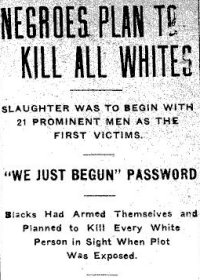
The Elaine massacre occurred on September 30–October 1, 1919 at Hoop Spur in the vicinity of Elaine in rural Phillips County, Arkansas. As many as several hundred African-Americans and five white men were killed. Estimates of deaths made in the immediate aftermath of the Elaine Massacre by eyewitnesses range from 50 to "more than a hundred". Walter Francis White, an NAACP attorney who visited Elaine shortly after the incident stated "... twenty-five Negroes killed, although some place the Negro fatalities as high as one hundred". More recent estimates of the number of black people killed during this violence are higher than estimates provided by the eyewitnesses, recently ranging into the hundreds. The white mobs were aided by federal troops and terrorist organizations like the Ku Klux Klan. According to the Encyclopedia of Arkansas, "the Elaine Massacre was by far the deadliest racial confrontation in Arkansas history and possibly the bloodiest racial conflict in the history of the United States".

Red Summer is the period from late winter through early autumn of 1919 during which white supremacist terrorism and racial riots took place in more than three dozen cities across the United States, as well as in one rural county in Arkansas. The term "Red Summer" was coined by civil rights activist and author James Weldon Johnson, who had been employed as a field secretary by the National Association for the Advancement of Colored People (NAACP) since 1916. In 1919, he organized peaceful protests against the racial violence which had occurred that summer.
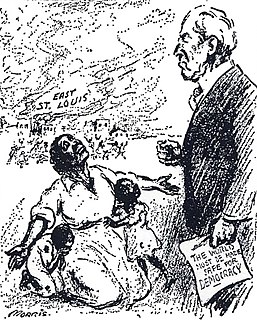
The East St. Louis Riots was a series of outbreaks of labor and race-related violence by White Americans who murdered between 39 and 150 African Americans in late May and early July 1917. Another 6,000 black people were left homeless, and the burning and vandalism cost approximately $400,000 in property damage. The events took place in and near East St. Louis, Illinois, an industrial city on the east bank of the Mississippi River, directly opposite the city of St. Louis, Missouri. The July 1917 episode in particular was marked by white-led violence throughout the city. The multi-day riot has been described as the "worst case of labor-related violence in 20th-century American history", and among the worst racial riots in U.S. history.

The Springfield race riot of 1908 consisted of events of mass racial violence committed against African Americans by a mob of about 5,000 white Americans and European immigrants in Springfield, Illinois, between August 14 and 16, 1908. Two black men had been arrested as suspects in a rape, and attempted rape and murder. The alleged victims were two young white women and the father of one of them. When a mob seeking to lynch the men discovered the sheriff had transferred them out of the city, the whites furiously spread out to attack black neighborhoods, murdered black citizens on the streets, and destroyed black businesses and homes. The state militia was called out to quell the rioting.
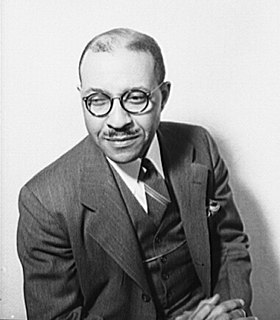
Charles Spurgeon Johnson was an American sociologist and college administrator, the first black president of historically black Fisk University, and a lifelong advocate for racial equality and the advancement of civil rights for African Americans and all ethnic minorities. He preferred to work collaboratively with liberal white groups in the South, quietly as a "sideline activist," to get practical results.

Violent attacks by armed mobs of White Americans against African Americans in Atlanta, Georgia, began on the evening of September 22, 1906, and lasted through September 24. The events were reported by newspapers around the world, including the French Le Petit Journal which described the "lynchings in the USA" and the "massacre of Negroes in Atlanta," the Scottish Aberdeen Press & Journal under the headline "Race Riots in Georgia," and the London Evening Standard under the headlines "Anti-Negro Riots" and "Outrages in Georgia." The final death toll of the conflict is unknown and disputed, but officially at least 25 African Americans and two whites died. Unofficial reports ranged from 10–100 black Americans killed during the massacre. According to the Atlanta History Center, some black Americans were hanged from lampposts; others were shot, beaten or stabbed to death. They were pulled from street cars and attacked on the street; white mobs invaded black neighborhoods, destroying homes and businesses.
The Commission on Interracial Cooperation (1918–1944) was an organization founded in Atlanta, Georgia, December 18, 1918, and officially incorporated in 1929. Will W. Alexander, pastor of a local white Methodist church, was head of the organization. It was formed in the aftermath of violent race riots that occurred in 1917 in several southern cities. In 1944 it merged with the Southern Regional Council.
The 1943Detroit race riot took place in Detroit, Michigan, of the United States, from the evening of June 20 through to the early morning of June 22. It occurred in a period of dramatic population increase and social tensions associated with the military buildup of U.S. participation in World War II, as Detroit's automotive industry was converted to the war effort. Existing social tensions and housing shortages were exacerbated by racist feelings about the arrival of nearly 400,000 migrants, both African-American and White Southerners, from the Southeastern United States between 1941 and 1943. The new migrants competed for space and jobs, as well as against European immigrants and their descendants. The riot escalated in the city after a false rumor spread that a mob of whites had thrown a black mother and her baby into the Detroit River. Blacks looted and destroyed white property as retaliation. Whites overran Woodward to Veron where they proceeded to tip over 20 cars that belonged to black families.

The Chicago race riot of 1919 was a violent racial conflict started by white Americans against black Americans that began on the South Side of Chicago, Illinois, on July 27 and ended on August 3, 1919. During the riot, 38 people died. Over the week, injuries attributed to the episodic confrontations stood at 537, with two thirds of the injured being black and one third white, and approximately 1,000 to 2,000, most of whom were black, lost their homes. Due to its sustained violence and widespread economic impact, it is considered the worst of the scores of riots and civil disturbances across the United States during the "Red Summer" of 1919, so named because of the racial and labor violence and fatalities. The prolonged conflict made it one of the worst riots in the history of Illinois.

The Southern Regional Council (SRC) is a reform-oriented organization created in 1944 to avoid racial violence and promote racial equality in the Southern United States. Voter registration and political-awareness campaigns are used toward this end. The SRC evolved in 1944 from the Commission on Interracial Cooperation. It is headquartered in Atlanta, Georgia.
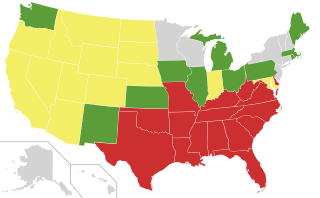
Interracial marriage in the United States has been legal throughout the United States since at least the 1967 U.S. Supreme Court decision Loving v. Virginia (1967) that held that "anti-miscegenation" laws were unconstitutional. Chief Justice Earl Warren wrote in the court opinion that "the freedom to marry, or not marry, a person of another race resides with the individual, and cannot be infringed by the State."
The Englewood race riot, or Peoria Street riot, was one of many post-World War II race riots in Chicago, Illinois that took place in November 1949.
Race relations is a sociological concept that emerged in Chicago in connection with the work of sociologist Robert E. Park and the Chicago race riot of 1919. Race relations designates a paradigm or field in sociology and a legal concept in the United Kingdom. As a sociological field, race relations attempts to explain how racial groups relate to each other, and in particular to give an explanation of violence connected to race.

The Longview race riot was a series of violent incidents in Longview, Texas, between July 10 and July 12, 1919, when whites attacked black areas of town, killed one black man, and burned down several properties, including the houses of a black teacher and a doctor. It was one of the many race riots in 1919 in the United States during what became known as Red Summer, a period after World War I known for numerous riots occurring mostly in urban areas.
The Anacostia Pool riot took place on June 29, 1949, at a recently-desegregated public swimming pool in the Anacostia neighborhood of Washington, DC. After two days of tense confrontations between white and black patrons of the pool, a two-hour large-scale disturbance involving 450 people resulted in five arrests and at least four serious injuries. Bill Mabry, one of the black swimmers involved, called the incident “Washington’s first race riot.” Despite pressure to relax the enforcement of the federal government’s nonsegregation policy, the Department of the Interior stated that “no backward step of any sort should be made in effectuating the President’s Civil Rights program,” specifically with respect to Washington, DC.
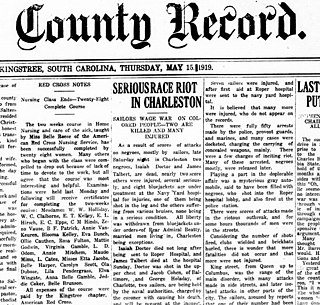
The Charleston riot of 1919 took place on the night of Saturday, May 10, between members of the US Navy and the local black population. They attacked black individuals, businesses, and homes killing six and injuring dozens.

The Johnson–Jeffries riots refer to the dozens of race riots that occurred throughout the United States after African-American boxer Jack Johnson defeated white boxer James J. Jeffries in a boxing match termed the "Fight of the Century". Johnson became the first black World Heavyweight champion in 1908 which made him unpopular with the predominately white audience of boxing. Jeffries, a former heavyweight champion came out of retirement to fight Johnson and was nicknamed the "Great White Hope". After Johnson defeated Jeffries on July 4, 1910, many whites felt humiliated and began attacking blacks who were celebrating Johnson's victory.

The Whatley, Alabama race riot of 1919 was a riot, gun battle between the local Black and White community on August 1, 1919.
References
- 1 2 3 4 5 6 7 The Negro in Chicago – A Study of Race Relations and a Race Riot, Chicago Commission on Race Relations, University of Chicago Press (1922), pps. xiv–xvii; OCLC 837716516, 1129752158, 1125769446, 1043990181, 7435468702, 7254809522, 1089762154
- ↑ "The Chicago Race Riot of 1919". History. History com. Retrieved 30 June 2019.
- ↑ Hamilton, with afterwords by the authors Kwame Ture & Charles V. (1992). Black power : the politics of liberation in America (Vintage ed.). New York: Vintage Books. pp. 152–153. ISBN 978-0-679-74313-2.
- 1 2 Drake, St Clair; Cayton, Horace R. (10 November 2015). Black Metropolis: A Study of Negro Life in a Northern City. University of Chicago Press. ISBN 9780226253350.